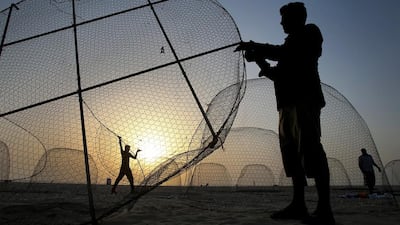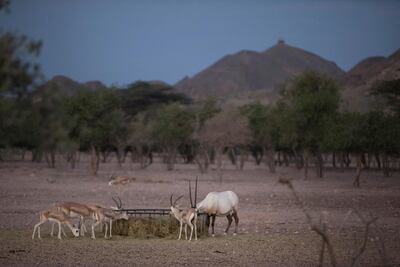Successful conservation measures are highlighted in the latest environmental annual report on Abu Dhabi’s wildlife.
The emirate has achieved record populations of both Arabian Oryx and two threatened species of sea mammals, says the Environment Agency Abu Dhabi.
The agency marks these as key achievements in its 2019 annual report, which came 25 years after the agency was founded.
On land, Abu Dhabi now hosts 5,000 Arabian Oryx, the largest herd in the world of a species that was once wiped out in the wild by hunting.
Conservation measures began in the 1980s by Sheikh Zayed, with the founding of Al Ain Zoo.
The waters of Abu Dhabi also contain the world’s largest number of Indian Ocean humpback dolphins, with the agency also monitoring more than 3,000 dugong, again more than anywhere else on the planet.

Sheikh Hamdan bin Zayed, the Ruler’s Representative in Al Dhafra and chairman of the agency, paid tribute to Sheikh Zayed for leading by example on environmental protection.
“Our priority is to address the local and global challenges of providing real environmental security, as well as outlining our efforts to protect biological diversity and the environment. These priorities stem from the UAE's keenness to conserve nature,” Sheikh Hamdan said.
“We will strive to protect the progress and achievements of this country over the past few years in order to achieve truly sustainable development within economic, social and environmental dimensions.”
The report reveals the agency has collected samples of nearly 2,500 invertebrate species, that include insects, worms and spiders, resulting in their conservation. Of these 100 were not previously known in the UAE.
By the end of the year, the number of land and maritime reserves managed by the Sheikh Zayed Protected Areas Network had grown to 19, covering 31 per cent of Abu Dhabi.
Working with the Ministry of Climate Change and Environment, the agency also launched a national recovery plan for fish stocks last year, with the banning of two nets known locally as gargoor and ghazal.
The gargoor or basket net is responsible for killing or injuring large numbers of sea turtles, as is the ghazal drift net, which catches sea creatures indiscriminately.
As part of its work as a regulatory authority, the authority reviewed more than 2,000 impact assessment studies, 4,800 environmental compliance inspections and issued more than 2,500 environmental licenses for industrial, commercial and development projects and facilities.
It monitors air quality through 20 fixed and two mobile stations and has also maintained and expanded a large network of marine water monitoring sites.
During the year it assessed 18,000 groundwater wells, leading to the launch of the Abu Dhabi Ground Water Atlas, with the aim of making water use more efficient.
The agency estimates that its message of improving environmental awareness reached more than eight of ten pupils in government and private schools in 2019, or around 1.8 million pupils.
Beyond the emirate, the agency has worked in Chad to successfully reintroduce the Scimitar-horned Oryx and set up similar programmes for the Addax and Dama gazelle.
Dr Shaikha Al Dhaheri, secretary general of the agency, said: “As always, the agency will work towards ensuring the sustainability of our natural resources and the continuity of a better life for future generations.”



